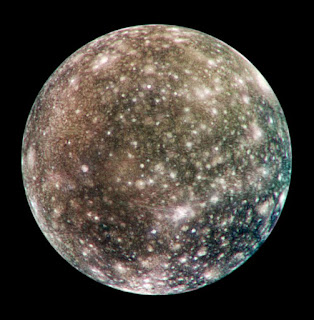- Callisto is the second-largest moon of Jupiter, after Ganymede. It is the third-largest moon in the Solar System after Ganymede and Saturn's largest moon Titan. It's actually not much smaller than the planet Mercury. Callisto’s circumference at its equator is about 9,410 miles (15,144 kilometers), about 99% the size of Mercury.
- Callisto orbits about 1,170,000 miles (1,883,000 kilometers) from Jupiter and is 628.3 million km from Earth.
- It takes about 17 (16.689) Earth days for Callisto to complete one orbit of Jupiter. It's tidally locked with the planet, which means the same side of Callisto always faces Jupiter.
- The surface of Callisto is covered in impact craters, so much so that any new ones are likely to erase an old one. There aren't any large mountains, and the fact that the craters are still there suggests there is no volcanic or tectonic activity there to erode them. Craters on Callisto are named after figures in Norse mythology. They include Burr, Lofn, Doh Hár and Tindr.
- There are two huge multi-ringed basins. The largest of these is called Valhalla and has a central region 600 kilometers in diameter, and rings extending as far as 1,800 kilometers. The other is called Asgard, with a diameter of 1,600 kilometers. There are also features called catenae, for example Gomul Catena. These consist of straight lines of craters, thought to have been caused by objects which broke up before impact.
- Callisto is made of rock and ice. Probes have detected that the moon has a small silicate core and that there are silicates and organic compounds there. It's possible there is an ocean of liquid salt Water beneath the surface. Therefore, it's on the list of places where there could be life, although conditions are thought to be more favourable for life on neighbouring Europa. Callisto's atmosphere is made up of Carbon dioxide and possibly Oxygen.
- Callisto is named after one of Zeus's many lovers. She was a nymph associated with the goddess of the hunt, Artemis. According to the myth, Zeus turned her into a Bear. For a long time, the names of Jupiter's four largest moons fell out of favour, only being revived as recently as the mid 20th century. Up until then, scientists referred to Callisto as Jupiter IV or as "the fourth satellite of Jupiter".
- Callisto has long been considered the most suitable place for a human base for future exploration of the Jovian system. That's a long way off, though. he next planned mission to the Jovian system is the European Space Agency's Jupiter Icy Moon Explorer (JUICE), due to launch in 2022. It isn't going to land there, merely perform some close flybys.
- Pictures taken by previous spacecraft show Callisto as being covered with bright white dots. Scientists think these are the peaks of the craters capped with water ice.
- Callisto has been mentioned in stories by HP Lovecraft, Isaac Asimov, Robert A Heinlein, Anne McCaffrey and Kim Stanley Robinson. In DC comics, 100,000 Kryptonians create a counter-Earth in the Solar System as their new home. They take Callisto for their moon so that their planet will have tides. Callisto has even been mentioned in a song by Blur, entitled Far Out.
I write fiction, too! My characters include some British superheroes and a psychic detective. You never know, your new favourite could be here! You won't know unless you look...
Browse other topics I've covered in this blog - HERE.
Like my Facebook page for news of Topical Ten posts, posts on my writing blog, and news of upcoming publications. |


No comments:
Post a Comment